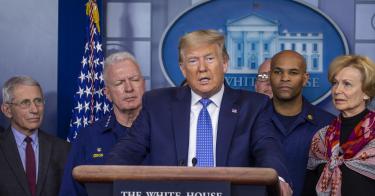History condemns generals who plan to fight the last war, rather than anticipate the challenges ahead. Effective leaders strive to get in front of the problem.
In his Rose Garden news conference Friday outlining the federal government’s next steps to get in front of the advancing coronavirus pandemic, President Donald Trump was much more forward-looking than his critics.
In battling an epidemic, the primary goal of public health officials is to slow the spread of disease to protect vulnerable populations. If they do not slow the spread, medical treatment facilities can be quickly overwhelmed, leading to delay or outright denial of care for many.
The travel bans established by the president aim to slow the entry of the coronavirus into the U.S. The social distancing policies being implemented by state and local governments, private organizations, and individuals aim to slow the spread within the country.
These actions have been largely successful to date. Our hospitals and intensive care units are not packed, much less turning away patients.
Yet the president has been harshly criticized by some for not doing more. Most of the criticism has focused on testing issues—and some of it is legitimate.
But testing is no silver bullet for stopping the disease COVID-19, which is caused by the coronavirus.
Right now, Job 1 remains slowing the spread of the disease and protecting vulnerable populations. That will see us through the remainder of the flu season, buying time for better therapeutics and vaccines and, yes, better testing. All of that will minimize severe sickness and deaths.
So what does the president’s Rose Garden declaration of a national emergency do to advance the fight against COVID-19?
Basically, it makes a lot of useful federal assets available to state and local governments. These governments bear the bulk of the responsibility for halting the spread of the coronavirus pandemic in our communities and dealing with its consequences.
In reality, there is no single declaration that constitutes a national emergency. There are well over 100 emergency executive powers that presidents may invoke. What Trump did was fashion a package of powers that will give states and communities what they need most.
For starters, the president evoked emergency authority to remove some restrictive red tape in the Medicare and Medicaid programs. This will quicken and expand access to medical services.
For example, patients enrolled in Medicare and Medicaid will now be able to take advantage of telemedicine, letting physicians do online or telephonic consultations and screenings without requiring patients to leave their homes and sit in crowded waiting rooms.
Trump also created new options for private sector initiatives, including better testing.
In addition, the president invoked the Stafford Act, one of the most commonly used sources of emergency authority. This act is usually used in responding to natural disasters like hurricanes and floods.
The Stafford Act was invoked most recently when tornadoes hit Tennessee. But some of its provisions can be useful in pandemic response—for example, in delivering federal aid and financial support to affected communities.
Declaring a national emergency is not a signal that it’s time to panic. Rather, it is a clear signal that the federal government will fulfill its role in responding to a crisis. And that role is to complement and reinforce state efforts—not to supplant them.
By invoking the Stafford Act, the president has given state and Native American tribal leaders greater access to the resources managed by the Federal Emergency Management Agency—from personnel experienced in complex response to funds for building temporary facilities, emergency shelters, bottled water rations, and much more.
The Stafford Act also opens access to the Disaster Relief Fund, which currently contains about $35 billion.
What the national emergency declaration does, then, is greatly expand the resources available to states and communities for dealing with coronavirus and the fallout from the pandemic. At this moment, it is the most meaningful and impactful step the administration can take on its own authority to deal with the situation
These emergency powers in no way impinge on the powers of Congress or the courts, nor do they significantly expand presidential power. They simply allow the president to execute authorities available to him under law.
As for those who suggest these powers will somehow enable the president to monkey with the elections or the census … that’s absolute nonsense.
These emergency powers respect federalism and reflect the U.S. disaster response system, which is fundamentally a bottom-up system. Local communities, territories, Native American tribes, and states retain primary responsibility for protecting their citizens.
But in times of emergency, these governments can request assistance from the federal government, which retains resources and authorities to support them.
What Trump is doing is reinforcing the front lines of the fight. Right now that is the single most critical part of the campaign to win the virus war.
This piece originally appeared in Fox News on 3/15/20




